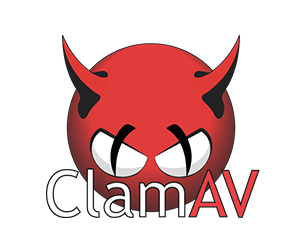TL;DR
- CentOSにClamAVをインストールしたい
- EPELからインストールするのが簡単
-
clamdおよびfreshclamの設定をする -
clamdscanを定期的に実行できるようにする
ClamAV
ClamAVは、オープンソースのアンチウイルスソフトウェアです。
スタンダードだよ(メールのスキャンで)、みたないことを言っています。
ClamAV® is the open source standard for mail gateway scanning software.
ClamAVの機能は、こちら。
- Command-line scanner
- Milter interface for sendmail
- Advanced database updater with support for scripted updates and digital signatures
- Virus database updated multiple times per day
- Built-in support for all standard mail file formats
- Built-in support for various archive formats, including Zip, RAR, Dmg, Tar, Gzip, Bzip2, OLE2, Cabinet, CHM, BinHex, SIS and others
- Built-in support for ELF executables and Portable Executable files packed with UPX, FSG, Petite, NsPack, wwpack32, MEW, Upack and obfuscated with SUE, Y0da Cryptor and others
- Built-in support for popular document formats including MS Office and MacOffice files, HTML, Flash, RTF and PDF
コマンドラインのスキャナーがあり、ウイルス定義データベースのアップデートが可能だったり、多くのファイルフォーマットをサポートしている、という感じです。
環境
インストール先のCentOSのバージョンは、こちらです。
/etc/redhat-release
CentOS Linux release 7.6.1810 (Core)
今回利用するClamAVのバージョンは、0.101.4です。
インストール
CentOSへのインストール手順はあるのですが、ソースコードからのコンパイルからになります。
Installation on Redhat and CentOS Linux Distributions
EPELを使用した導入方法も書かれているので、今回はこちらを使いましょう。
EPELを有効にする
今回のClamAVは
$ sudo yum install epel-release
必要なパッケージをインストールする
以下のコマンドで、必要なパッケージをインストールします。
$ sudo yum install clamav clamav-update clamd
各パッケージに含まれている役割は以下に書かれています。
clamd
ファイルに対するウイルススキャンの機能を提供するDaemonで、他のツールと連動して動作します。
clamdscan
スキャンクライアントで、clamdと連動して動作します。
on-access scanning
リアルタイムプロテクション機能をclamdに提供します(オンアクセススキャン)。
こちらは、参考程度に。
freshclam
ClamAVのウイルス定義データベースのダウンロード、更新を行います。
freshclamの設定とウイルス定義データベースの初回作成
freshclamを使用して、clamdが使用するウイルス定義データベースの初回作成を行います。これをやらないと、clamdが起動できません。
freshclamの設定ファイル、/etc/freshclam.confを修正します。
ウイルス定義に更新があった場合の通知先となる、clamdの設定ファイルパスのコメントアウトを解除し、以下のように設定します。
NotifyClamd /etc/clamd.d/scan.conf
インターネットアクセスにプロキシサーバーが必要な場合は、以下を設定してください。
#HTTPProxyServer myproxy.com
#HTTPProxyPort 1234
以下のコマンドを実行すると、ウイルス定義ファイルをダウンロードしてきて、データベースを作成します。
$ sudo freshclam
以降は、/etc/cron.d/clamav-updateによりcronで自動アップデートされます。
## user 'clamupdate' as soon as possible
0 */3 * * * root /usr/share/clamav/freshclam-sleep
clamdの設定を行う
設定ファイル/etc/clamd.d/scan.confを修正します。
このファイルにExapmleと書かれたままだとちゃんと動作しないので、
# Comment or remove the line below.
Example
これをコメントアウトします。
# Comment or remove the line below.
#Example
また、TCPソケットもしくはUNIXドメインソケットを使ってサーバーを起動する必要があるので、今回はUNIXドメインソケットを使用します。
# Path to a local socket file the daemon will listen on.
# Default: disabled (must be specified by a user)
LocalSocket /var/run/clamd.scan/clamd.sock
また、実行ユーザーはrootにしておきます。
User root
/procや/sysはスキャン除外設定にしておくと良いでしょう(コメントアウトを解除すればOKです)。
ExcludePath ^/proc/
ExcludePath ^/sys/
systemdでclamd@scanを有効化して、clamd@scanを起動。
$ sudo systemctl enable clamd@scan
$ sudo systemctl start clamd@scan
SELinuxが有効な場合は、antivirus_can_scan_systemをonにしておきます。
$ sudo setsebool -P antivirus_can_scan_system on
参考:オンアクセススキャンの設定
ClamAVでは、オンアクセススキャンを行うこともできます。
以下のドキュメントに沿って、ScanOnAccess、OnAccessIncludePath、OnAccessPreventionを設定します。
clamdだけでは、スキャンは行われません。
スキャンを行う、clamdscanの利用が必要です。
※clamscanというコマンドで、clamdなしで実行もできますが、こちらは参考程度に
確認
スキャンは、clamdscanを使用して行います。
テスト用のウイルス入りファイルをダウンロードして、確認してみます。
$ cd /tmp
$ wget https://secure.eicar.org/eicar.com
$ wget https://secure.eicar.org/eicar.com.txt
$ wget https://secure.eicar.org/eicar_com.zip
$ wget https://secure.eicar.org/eicarcom2.zip
以下のように、-cで設定ファイルを指定し、/で全ディレクトリをスキャンしてみましょう。
$ sudo clamdscan -c /etc/clamd.d/scan.conf /
スキャン結果の中に、以下のような出力が含まれているはずです。
/tmp/eicar_com.zip: Eicar-Test-Signature FOUND
/tmp/eicar.com.txt: Eicar-Test-Signature FOUND
/tmp/eicar.com: Eicar-Test-Signature FOUND
/tmp/eicarcom2.zip: Eicar-Test-Signature FOUND
なお、実行にはけっこうリソースを使い、CPUひとつとメモリ1Gくらいを使ったりしてました…。
これを削除する場合は、--removeを付与してclamdscanを実行します。
$ sudo clamdscan -c /etc/clamd.d/scan.conf --remove /
検出されたファイルは、削除されます。
/tmp/eicar_com.zip: Eicar-Test-Signature FOUND
/tmp/eicar_com.zip: Removed.
/tmp/eicar.com.txt: Eicar-Test-Signature FOUND
/tmp/eicar.com.txt: Removed.
/tmp/eicar.com: Eicar-Test-Signature FOUND
/tmp/eicar.com: Removed.
/tmp/eicarcom2.zip: Eicar-Test-Signature FOUND
/tmp/eicarcom2.zip: Removed.
どこか別のディレクトリに退避する場合は、--moveと退避先のディレクトリを指定してclamdscanを実行します。
$ sudo clamdscan -c /etc/clamd.d/scan.conf --move [検出したウイルスの退避先ディレクトリ] /
例えば、以下のようなディレクトリを作成して退避するようにする場合は…
$ mkdir /tmp/clamdscan-quarantinedir
設定ファイル/etc/clamd.d/scan.confを修正して、退避先をスキャン対象外にして
ExcludePath ^/tmp/clamdscan-quarantinedir/
実行。
$ sudo clamdscan -c /etc/clamd.d/scan.conf --move /tmp/clamdscan-quarantinedir /
今度は、退避が行われます。
/tmp/eicarcom2.zip: Eicar-Test-Signature FOUND
/tmp/eicarcom2.zip: moved to '/tmp/clamdscan-quarantinedir/eicarcom2.zip'
/tmp/eicar.com: Eicar-Test-Signature FOUND
/tmp/eicar.com: moved to '/tmp/clamdscan-quarantinedir/eicar.com'
/tmp/eicar_com.zip: Eicar-Test-Signature FOUND
/tmp/eicar_com.zip: moved to '/tmp/clamdscan-quarantinedir/eicar_com.zip'
/tmp/eicar.com.txt: Eicar-Test-Signature FOUND
/tmp/eicar.com.txt: moved to '/tmp/clamdscan-quarantinedir/eicar.com.txt'
定期的にスキャンする
定期的にスキャンを行うには、clamdscanをcronで定期実行するように仕込めばOKです。
0 3 * * * clamdscan -c /etc/clamd.d/scan.conf --remove /
検出したファイルを退避する場合は、--moveと組み合わせるとよいでしょう。
clamd、freshclamのログ設定
clamdにもfreshclamにも、ログ出力設定があります。デフォルトではsyslogを使うように構成されていますが、必要に応じて設定しましょう。
clamdの場合はこのあたりを
LogFile
LogFileMaxSize
LogTime
LogRotate
freshclamの場合は、このあたりを設定します。
UpdateLogFile
LogFileMaxSize
LogTime
LogRotate
